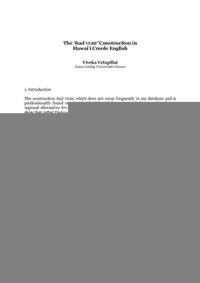
Ebook: The ‘had VERB’ Construction in Hawai‘i Creole English
Author: Viveka Velupillai
- Genre: Linguistics // Foreign
- Tags: Языки и языкознание, Полинезийские языки, Гавайский язык
- Language: Hawaiian-English
- pdf
Publication date: 2004
Number of pages: 20The construction had VERB, which does not occur frequently in my database and is predominantly found on the island of Kaua‘i, has previously been analysed as a regional alternative for the anterior or the simple past tenses. In this article I will show that rather than carrying any inherent temporal connotations, it grammatically encodes the perspective taken on an event, making it an aspectual marker and not a tense marker. In fact, it can readily combine with and occur alongside the simple past tense, which is an inflected form, or the base form, which is a relative tense that may also refer to the (relative) past, in which case it functions as an anterior. However, the fact that the form may combine with the past tense does not necessarily mean that it denotes it.
The article is structured as follows: in the remainder of this section I will first give a short socio-historical background to Hawai‘i Creole English (HCE), then provide a short note on the conventions used for the examples in this article. In order to show how the construction had VERB relates to the other tense and aspect categories in the grammar, I will give a snapshot of the HCE tense (section 2) and aspect systems (section 3) before I discuss the construction had VERB itself (section 4). Because I use a specialised framework for the description of the had VERB construction, I will give a short introduction to this framework in section (4.1) before moving on to discuss the had VERB construction in detail (4.2). The last section of the paper (5) will offer a summary and conclusion.
Number of pages: 20The construction had VERB, which does not occur frequently in my database and is predominantly found on the island of Kaua‘i, has previously been analysed as a regional alternative for the anterior or the simple past tenses. In this article I will show that rather than carrying any inherent temporal connotations, it grammatically encodes the perspective taken on an event, making it an aspectual marker and not a tense marker. In fact, it can readily combine with and occur alongside the simple past tense, which is an inflected form, or the base form, which is a relative tense that may also refer to the (relative) past, in which case it functions as an anterior. However, the fact that the form may combine with the past tense does not necessarily mean that it denotes it.
The article is structured as follows: in the remainder of this section I will first give a short socio-historical background to Hawai‘i Creole English (HCE), then provide a short note on the conventions used for the examples in this article. In order to show how the construction had VERB relates to the other tense and aspect categories in the grammar, I will give a snapshot of the HCE tense (section 2) and aspect systems (section 3) before I discuss the construction had VERB itself (section 4). Because I use a specialised framework for the description of the had VERB construction, I will give a short introduction to this framework in section (4.1) before moving on to discuss the had VERB construction in detail (4.2). The last section of the paper (5) will offer a summary and conclusion.
Download the book The ‘had VERB’ Construction in Hawai‘i Creole English for free or read online
Continue reading on any device:

Last viewed books
Related books
{related-news}
Comments (0)